How Plate Heat Exchangers Work. In this presentation we’ll learn How Plate and Frame Heat Exchangers work. These maybe referenced on engineered drawings as HEX, HX, PHX or PHE. Plate and frame heat exchangers are used in the HVAC and Plumbing industry for the transfer of heat from one system to another without the fluids meeting each other. The purpose of the heat exchanger is to transfer thermal energy from one system to another without the fluids contacting each other.
If you prefer to watch the Video of this Presentation, then scroll to the bottom or click this link. How Plate Heat Exchangers Work
The two most common types of heat exchangers are the shell and tube heat exchanger and the plate and frame type that we are going to discuss here.
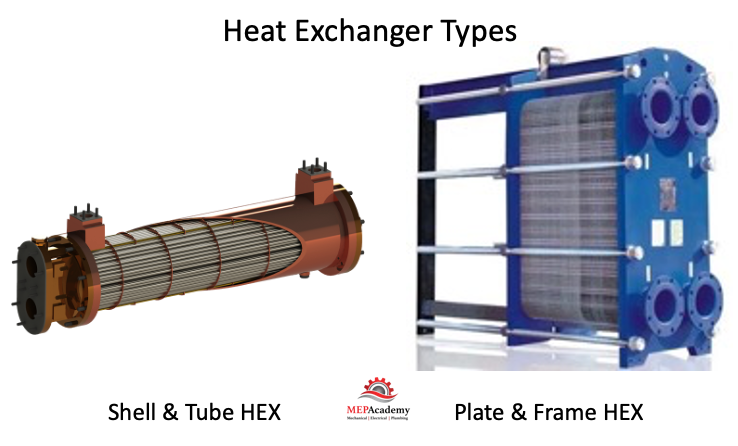
A Plate and frame heat exchangers can be used for a water side economizer, where one side is connected to the cooling towers, and the other side is connected to the chilled water distribution piping. This keeps the cooling tower water separate from the chilled water loop.
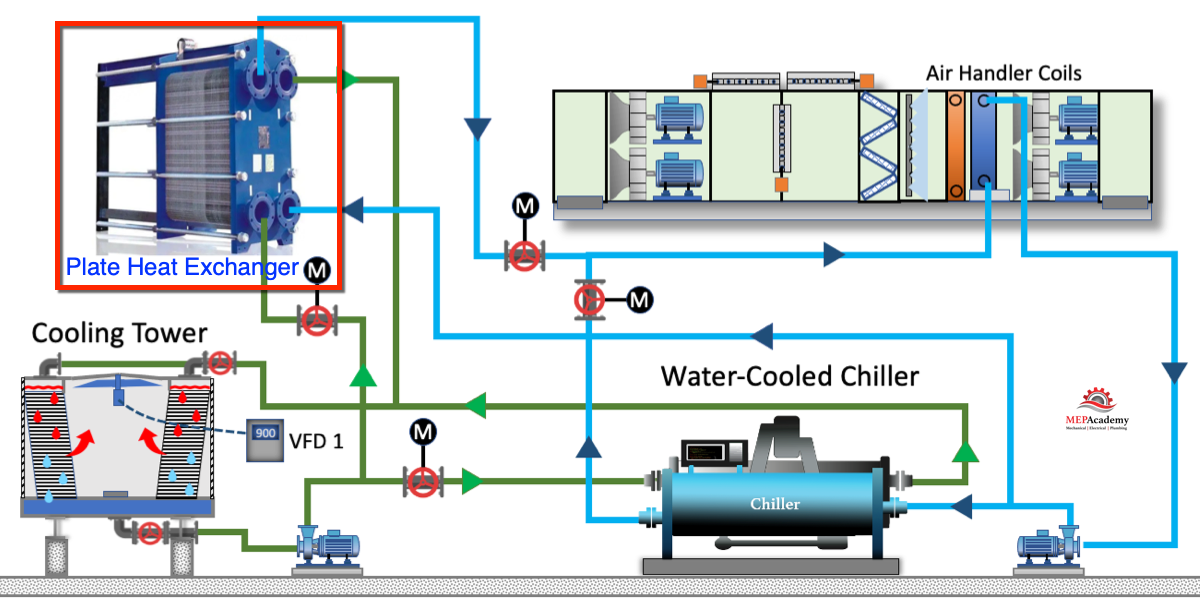
Parts of a Plate and Frame Heat Exchanger
There are very few parts for a Plate and Frame heat exchanger which can be used with fluids or gases. They will contain threaded or flanged inlet and outlet connections for both the primary and secondary sides of the heat exchanger. One set of inlet and outlet connection will be considered the hot side and the other the cold, as heat will move from the warmer to the colder fluid or gas, hence exchanging heat.
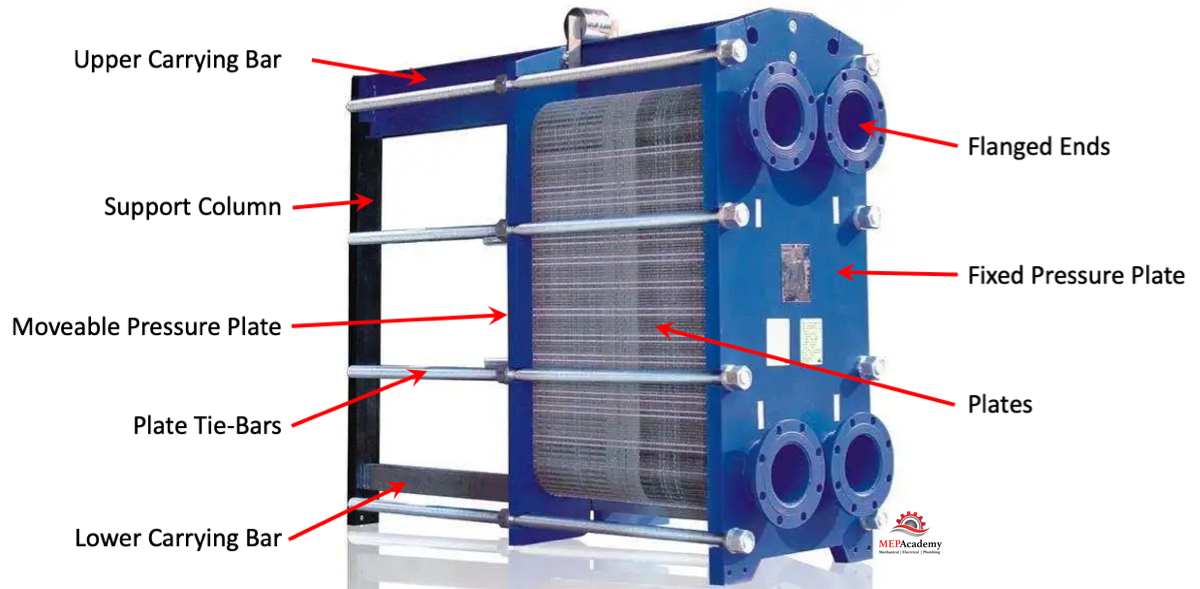
The plate and frame heat exchangers are like a sandwich, where you have two slices of bread or in our case two thick sheets of mild steel that form the ends, with layers of thin, gasketed, corrugated plates sandwiched in-between. One end is a fixed plate, while the other end is movable pressure plate. The fixed plate end will have holes in it for the piping connections. For the HVAC and Plumbing trades, the use of stainless-steel plates is common and can be either 316 SS or the less expensive 304 SS.
There are top and bottom carrier bars between the two end plates from which all the gasket plates are supported from which also provides a method for their alignment. The gasketed plates are grooved along their top to fit onto the carrier bar.
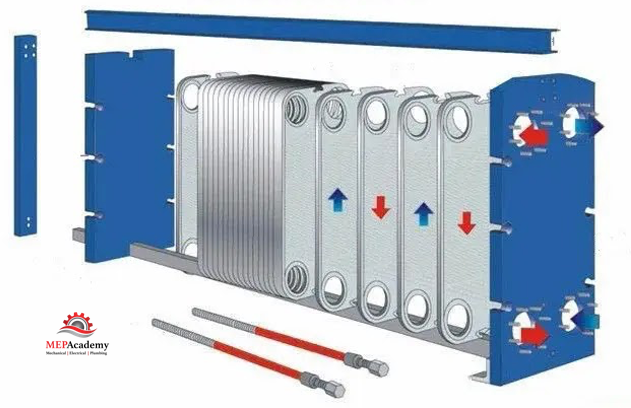
Then there is a long clamping or tightening bolts that run the length of the heat exchanger from one end plate to the other that will tighten all the plates firmly together. There is a gasket on one side of each plate that when the bolts are tightened, all the plates are squeezed together between the two end plates ensuring a watertight seal. The gasket can be made of nitrile or EPDM, both synthetic forms of rubber.
How Plate & Frame Heat Exchanger Work
The warm fluid will enter the inlet on the primary side of the fixed end where the gasketed plates will route the fluid through the first plate and every other plate or odd numbered plate and then exit the outlet piping connection. The cold fluid will enter the inlet on the secondary side of the fixed end and be routed to the second plate and every other plate or ever even numbered plate, before exiting the outlet pipe connection on the fixed end.
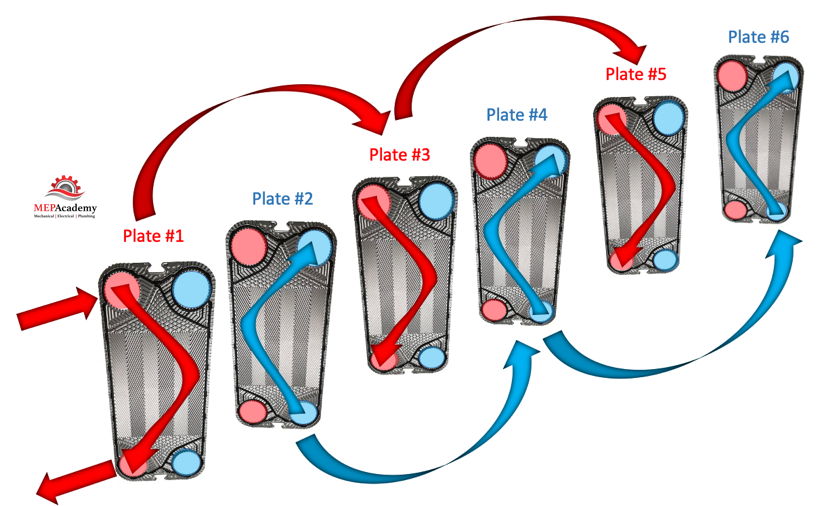
The primary fluid never mixes with the secondary fluid, they just transfer their heat between the plates surface area in an alternating pattern of hot and cold plates. The hot fluid will give up some of its heat and become cooler, while the cold fluid will pick up some of that heat and become warmer.
Remember that the natural laws state that heat will leave the warmer fluid and transfer to a cooler fluid in its attempt to reach equilibrium along as there is a temperature difference between them. The heat given up by the warmer fluid is equal to the heat gained by the cooler fluid, minus any heat lost to the surroundings.
The plates are thin and close together to provide good thermal contact and heat transfer. The thin metal and large surface area provides a means for high thermal conductivity and heat transfer between the two fluids.
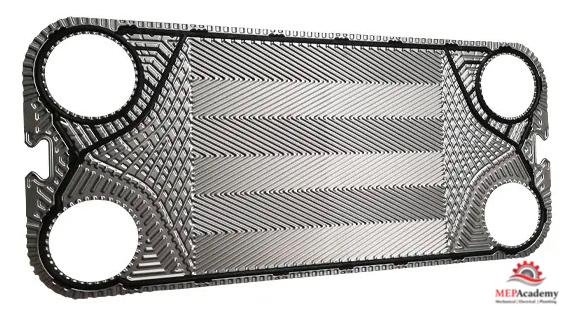
The plates come stamped with many different patterns on their face and will have four holes in their corners where the main fluid or gas flows. The patterns are designed to increase turbulent flow which increases the rate of heat transfer and prevents the accumulation of mineral buildup on the plates. The various stamped metal patterns also provide rigidity to the plates.
There will be a starting and ending plate. These plates prevent the fluid or gas from getting behind them and in-between the fixed and movable end covers.
Increasing Heat Exchanger Capacity
One of the benefits for using a Plate and Frame heat exchanger is the ease by which additional capacity can be added. There are several methods that can be deployed to increase the capacity of a heat exchanger.
One method is to increase the number of plates which will increase the heat exchangers capacity, or if you want to reduce capacity, then remove some plates.
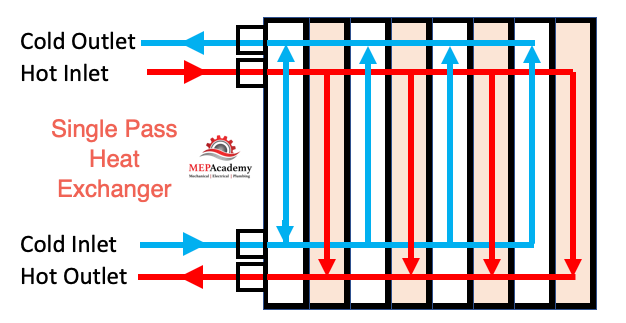
Increase the number of passes that the fluid travels through the heat exchanger. A single pass heat exchanger is where the fluid passes through a single plate and then exits. A multiple pass heat exchanger will send the fluid through more than one plate before it exits. A multiple pass heat exchanger gives the fluid more time to transfer heat.

Another way to increase capacity is to increase the flow rate through the plates.
For higher pressure systems there is the option is to use brazed, welded or fusion-bonded plates.
Flow Patterns through Heat Exchanger
There are three common methods of how the flow of fluid traverses the plates in relationship between the primary and secondary fluids. They can flow in the same direction which is considered parallel flow. They can flow in opposite direction to each other and that would be counter flow. Then there is cross flow, where one fluid travels perpendicular to the other.
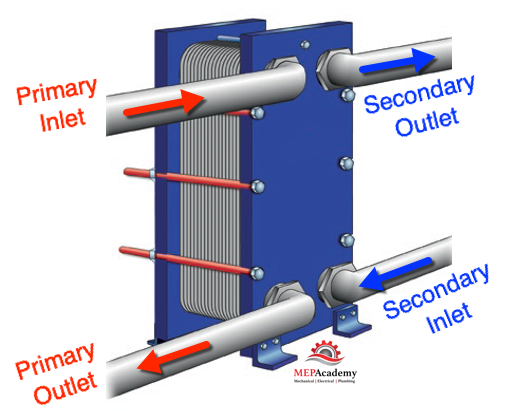
Where can they be used?
Here is a possible list of places you could find plate and frame heat exchangers in the HVAC and Plumbing Industry. For areas where freezing is possible, then the use of a Water/Glycol solution can be used but will require a slight larger heat transfer area.
- Heat Recovery Applications like heat from a chiller or generator
- Water-side economizer
- Swimming pools or Spa’s
- District Heating or Cooling
- Preheating of Domestic Water
- Preheating of Boiler Feedwater
- Process heating or cooling
- Solar Heating
- Water-Cooled Heat Pumps
Advantages of Plate and Frame Heat Exchangers
- They take up less space.
- They weigh less.
- They are more efficient.
- Easy to clean plates.
- Longer intervals between cleanings.
- Less space required for dismantling.
- Easier to increase capacity with gasketed versions.
- Close approach temperatures







